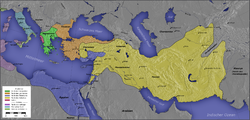Empayar Seleukia
Penampilan
Empayar Seleukos Βασιλεία τῶν Σελευκιδῶν Basileía tōn Seleukidōn | |||||||||||||||
|---|---|---|---|---|---|---|---|---|---|---|---|---|---|---|---|
| 312 SM–63 SM | |||||||||||||||
 Wilayah kerajaan (warna kuning). | |||||||||||||||
| Status | Kerajaan pangkuan panglima | ||||||||||||||
| Ibu negara | Seleukeia (305 SM – 240 SM) Antiokhia (240 SM – 64 SM) | ||||||||||||||
| Bahasa yang umum digunakan | Yunani | ||||||||||||||
| Agama | Agama Yunani Purba | ||||||||||||||
| Kerajaan | Beraja | ||||||||||||||
| Raja | |||||||||||||||
• 305 SM – 281 SM | Seleukos I | ||||||||||||||
• 65 SM – 63 SM | Filippos II | ||||||||||||||
| Era Sejarah | Yunani | ||||||||||||||
• Didirikan | 312 SM | ||||||||||||||
| 64 SM | |||||||||||||||
• Raja terakhir tumpas; Syria menjadi provinsi Rom | 63 SM | ||||||||||||||
| Keluasan | |||||||||||||||
| 301 SM[1] | 3,000,000 km2 (1,200,000 bt2) | ||||||||||||||
| 240 SM[1] | 2,600,000 km2 (1,000,000 bt2) | ||||||||||||||
| 175 SM[1] | 800,000 km2 (310,000 bt2) | ||||||||||||||
| 100 SM[1] | 100,000 km2 (39,000 bt2) | ||||||||||||||
| |||||||||||||||
Empayar Seleukos (Bahasa Yunani Kuno: Βασιλεία τῶν Σελευκιδῶν, Basileía tōn Seleukidōn) merupakan kerajaan bangsa Yunani[2][3] yang wujud berikutan pembahagian belah timur kerajaan Makaduniah milik Alexander Agung yang diserahkan kepada salah seorang panglima baginda Seleukos (Σέλευκος Séleukos) dan wangsa kerabatnya pada 312 SM.[4][5][6][7] Ia berpusat di Asia Barat Daya, di jajahan Empayar Parsi Hakhamaniyah awal di Asia. Pada kemuncak kuasanya, wilayah-wilayahnya merangkumi tengah Anatolia, Syam, Mesopotamia, Parsi, Turkmenistan moden, Pamir dan sebahagian Pakistan.
Ia merupakan sebuah pusat tumpuan utama budaya dan sastera bangsa Yunani.[8]
Rujukan
[sunting | sunting sumber]- ^ a b c d Taagepera, Rein (1979). "Size and Duration of Empires: Growth-Decline Curves, 600 B.C. to 600 A.D." Social Science History. 3 (3/4): 121. doi:10.2307/1170959.
- ^ Niknami, Kamal-Aldin; Hozhabri, Ali (2020). Archaeology of Iran in the Historical Period (dalam bahasa Inggeris). Springer Nature. m/s. viii. ISBN 978-3-030-41776-5.
Most of the Asiatic occupations of Alexander, Iran as the core of them, were given to Seleucus I at first. Thus, Iran came under the ruling of the Seleucid. The Seleucid was a Greek state that commanded Western Asia between 312 and 64 BC. The Seleucid Empire was founded by Seleucus I.
- ^ Eckstein, Arthur M. (2009). Mediterranean Anarchy, Interstate War, and the Rise of Rome (dalam bahasa Inggeris). University of California Press. m/s. 106. ISBN 978-0-520-25992-8.
By 201–200 it appeared that the old structure would be replaced by a tremendous expansion in the power of two already formidable Greek states –Antigonid Macedon and the Seleucid Empire– or perhaps even that one of these two formidable powers would emerge the sole victor.
- ^ Jones, Kenneth Raymond (2006). Provincial reactions to Roman imperialism: the aftermath of the Jewish revolt, A.D. 66–70, Parts 66–70. University of California, Berkeley. m/s. 174. ISBN 978-0-542-82473-9.
... and the Greeks, or at least the Greco-Macedonian Seleucid Empire, replace the Persians as the Easterners.
- ^ Society for the Promotion of Hellenic Studies (London, England) (1993). The Journal of Hellenic studies, Volumes 113–114. Society for the Promotion of Hellenic Studies. m/s. 211.
The Seleucid kingdom has traditionally been regarded as basically a Greco-Macedonian state and its rulers thought of as successors to Alexander.
- ^ Baskin, Judith R.; Seeskin, Kenneth (2010). The Cambridge Guide to Jewish History, Religion, and Culture. Cambridge University Press. m/s. 37. ISBN 978-0-521-68974-8.
The wars between the two most prominent Greek dynasties, the Ptolemies of Egypt and the Seleucids of Syria, unalterably change the history of the land of Israel…As a result the land of Israel became part of the empire of the Syrian Greek Seleucids.
- ^ Glubb, John Bagot (1967). Syria, Lebanon, Jordan. Thames & Hudson. m/s. 34. OCLC 585939.
In addition to the court and the army, Syrian cities were full of Greek businessmen, many of them pure Greeks from Greece. The senior posts in the civil service were also held by Greeks. Although the Ptolemies and the Seleucids were perpetual rivals, both dynasties were Greek and ruled by means of Greek officials and Greek soldiers. Both governments made great efforts to attract immigrants from Greece, thereby adding yet another racial element to the population.
- ^ Britannica, Seleucid kingdom, 2008, O.Ed.
- A. Houghton, C. Lorber, Seleucid Coins. A Comprehensive Catalogue, Part I, Seleucus I through Antiochus III, With Metrological Tables by B. Kritt, I-II, New York - Lancaster - London, 2002.
- G. G. Aperghis, The Seleukid Royal Economy. The Finances and Financial Administration of the Seleukid Empire, Cambridge, 2004.
- Laurent Capdetrey, Le pouvoir séleucide. Territoire, administration, finances d'un royaume hellénistique (312-129 avant J.C.). (Collection "Histoire"). Rennes: Presses Universitaires de Rennes, 2007.
Pautan luar
[sunting | sunting sumber]- Livius, The Seleucid Empire by Jona Lendering
- Genealogy of the Seleucids Diarkibkan 2009-03-22 di Wayback Machine
Kategori:
- Pages using the EasyTimeline extension
- Rencana yang mengandungi teks bahasa Yunani Purba (sehingga 1453)
- Rencana bekas negara yang dikategorikan mengikut jenis kerajaan
- Pembubaran 63 SM
- Negara dan wilayah wujud pada 312 SM
- Empayar Seleukos
- Sejarah Parsi
- Sejarah Syria
- Sejarah Iraq
- Sejarah Iran
- Sejarah Azerbaijan purba
- Sejarah purba Pakistan
- Sejarah Wilayah Perbatasan Barat Laut


